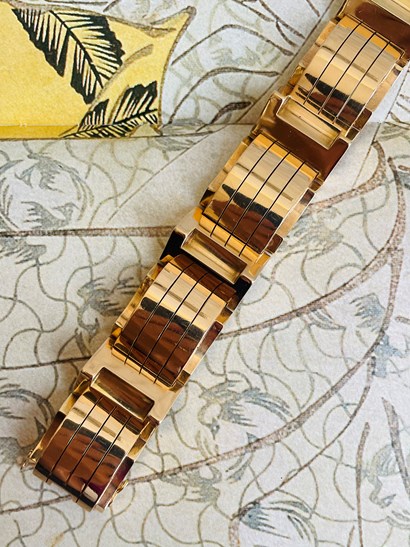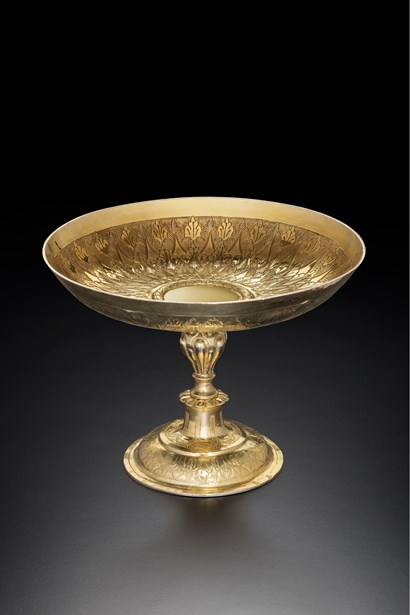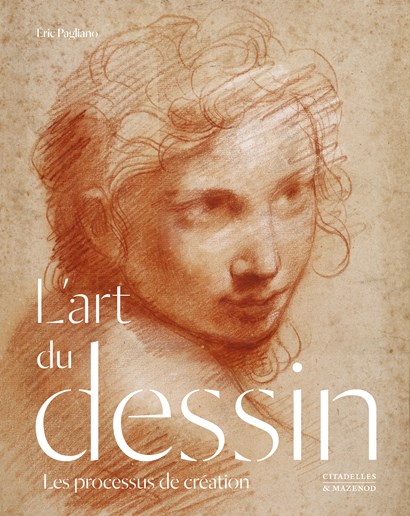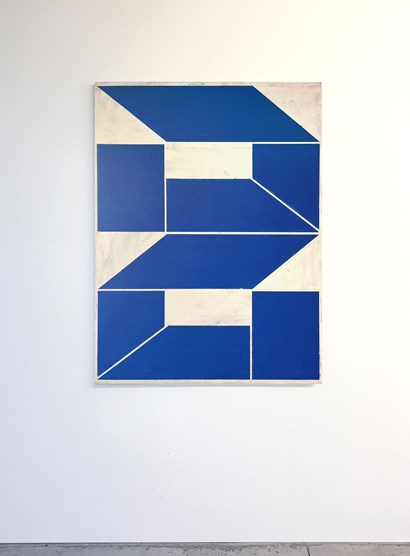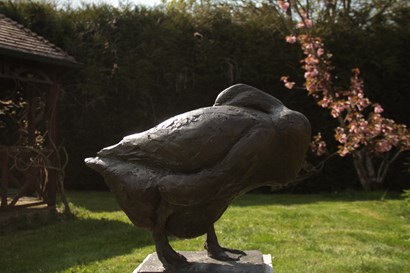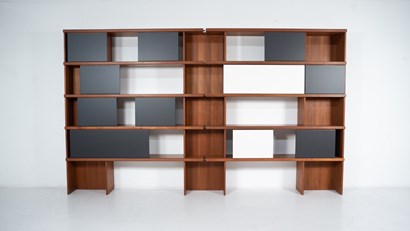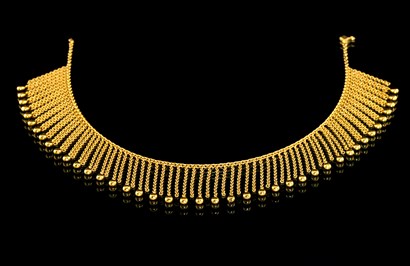This section will be available this Autumn.

Van Herck-Eykelberg
Asger Jorn (Denmark, Jutland 1914-1973 Aarhus) The girl and the bird, 1940 Oil on canvas 44 x 69 cm Signed and dated lower right Literature: Guy Atkins, Jorn in Scandinavia 1930-1953, London, 1968, n° 156, ill. p. 333 Exhibitions: 13 kunstnere i telt, Bellevue, Copenhagen, 17 May-8 June 1941, cat. n° 61; Jorn, Arken Museum for Moderne Kunst, Ishøj, Denmark, 14 September 2002-19 January 2003, Cobra Museum voor Moderne Kunst, Amstelveen, The Netherlands, 7 February-27 April 2003 and Kunsthalle zu Kiel, Germany, 17 May-10 August 2003, cat. n° 8, ill. cat. p. 56 (in colour); Jorn-Picasso. Myter og Møder. Myths & Meetings', Museum Jorn, Silkeborg, 7 September-8 December 2013, cat. n° 6, ill. cat. p. 72 (in colour); Cobra Museum voor Moderne kunst, Amstelveen, The Netherlands, 2013
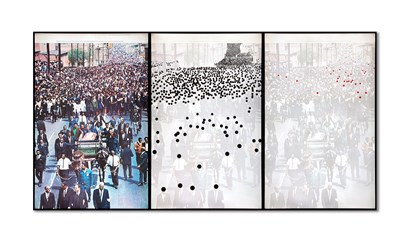
Galerie La Patinoire Royale Bach
alfredo jaar
Alfredo Jaar (Chili, Santiago 1956) Life Magazine, 19 April 1968 1995 Three lightboxes, analog C-print on Duratrans 183 x 360 cm (entire dimension) 183 x 120 cm (one lightbox) Unique piece Life Magazine, 19 April 1968 (1995) by Alfredo Jaar is one of the Chilean artist’s iconic lightbox works in which he pointillistically engages an image from the public archive, intervening with his signature cutting precision to highlight social inequities and the politics of image making. The source image for this work is a documentary photograph of Martin Luther King’s funeral printed in 1968 in Life Magazine, the magazine of reference for a generation of Americans. In the image, a horse drawn casket is surrounded by supporters, and behind, a crowd fills the boulevard, stretching into the vanishing point beyond. It is a powerful representation of the late civil rights leader’s influence. The source photograph is presented large scale on the left third of the lightbox. In the center, the image is whited over, and in the place of faces in the crowd are black dots, massing and overflowing the street. In the rightmost part of the triptych, the source image is similarly whited out, but this time only a smattering of red dots appear — a handful scattered across the crowd. The artist placed black dots on the faces of African Americans. The red dots highlight White attendees. Created while Jaar was researching the Life archives for another iconic lightbox work, Searching for Africa in Life (1996), in which the artist reprints every cover of the magazine, highlighting through the punctum of the title the glaring absence of adequate representation of the continent, Life Magazine, 19 April 1968 (1995) similarly makes manifest a glaring absence. Through the precision of the artist’s intervention, and rendered in the artist’s signature clean lines, a singular gesture evokes the imbroglia of lingering racism and inequality in contemporary society.

Almine Rech
hans op de beeck
Hans Op de Beeck (Turnhout, 1969) Crow, 2025 MDF, metal, polyamide, coating and bronze H 160 x W 80 x D 56 cm - Weight 39 kg Edition of 5 plus 2 APs Provenance: Studio of the Artist 'Crow' is a kinetic sculpture of a life-size flying crow. Powered by a mechanical system, the crow's flight creates the illusion of forward motion, although it remains suspended in place. 'Crow' evokes the world of fables and classic animated films, in which animals take on human traits. The work also alludes to the age-old tradition of mechanically animated figures, whose repetitive, joyless movements often inspire a quiet melancholy. At the same time, it is striking how lifelike and fluid such mechanically simplified movements can sometimes appear.
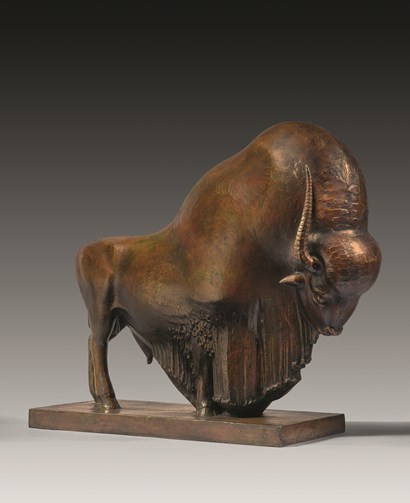
Galerie Nicolas Bourriaud
jacq orlande sinapi
Jacq Orlande Sinapi (Marseille, 1911-1989) Bison, circa 1940 Bronze with nuanced brown patina Cast by Leblanc-Barbedienne and bearing the foundry's stamp H 50 x W 57 x D 21 cm Signed ‘Jacq Orlande Sinapi’ Only two pieces known to date Provenance: private collection, France

Barbara Bassi
Arman (Nice 1928-2005 New York) Musical instruments bracelet, circa 1990 Diamonds and 18 kt yellow gold Unique piece signed and dedicated by Arman 'Arman for Janadine' Sonia Delaunay (Ukraine, Hradyz'k 1885-1979 Paris) Flamenco, 1979 Silver metal and enamel Limited edition Provenance: private collection, USA Literature: Cover of catalogue 'Bijoux d'artistes de Calder à Koons' by Diane Venet (Flammarion), Musée d'Art Décoratif, Paris, 2018
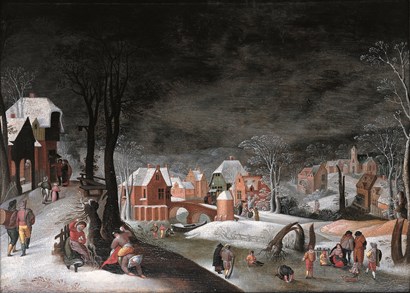
Galerie Florence de Voldère
jacob grimmer
Jacob Grimmer (Antwerp, 1525-1590) Winter landscape Oil on panel 37.3 x 51 cm Provenance: Antonie Palamedes Stevens (1601-1673), painter and collector; private collection, Austria; sale Versailles, 1937; private collection, Paris; sale Galliera, Paris, 29 November 1973 n° 20,21,22,23; private collection, Brussels Literature: R. de Bertier, Jacob et Abel Grimmer, 1991, ill. pp. 104-108 Received as a master of the Guild in 1547, Jacob Grimmer is amongst the great pioneering painters in the history of Northern painting. A contemporary of Pieter Bruegel the Elder, he shared with him a passion for nature; like him, he painted from life, and his works are filled with realism and genuine emotion. It is through the recurring theme of the seasons in his work that Jacob Grimmer expresses his innovative vision of the landscape, where shifting atmospheric moods adapt to everyday and secular scenes.
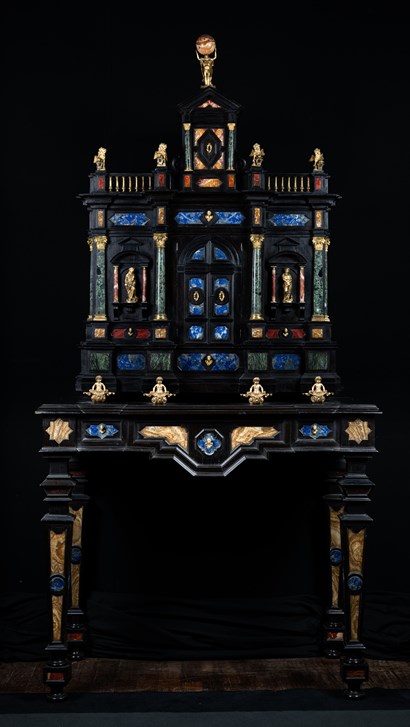
Carlucci Gallery
Roman Cabinat, circa 1780 Ebony veneered, marble and various polychrome stones H 208 x W 105 x D 62 cm Provenance: private collection Cabinet veneered in ebony, marble, and polychrome stones, with an architectural design. The upper section features a tympanum surmounted by Hercules holding the globe in flowering alabaster. A pierced balustrade is crowned with figures of a winged lion bearing a heraldic shield. The façade is articulated with a central door and two lateral doors, each concealing interior disappearing drawers. Materials include jasper, lapis lazuli, breccia, alabaster, and antique green marble.
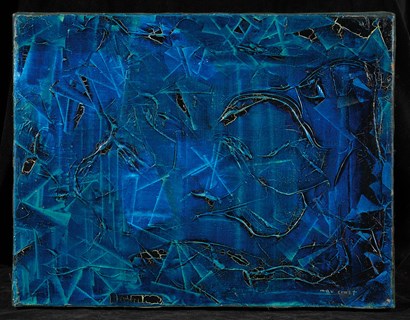
Beck & Eggeling International Fine Art
max ernst
Max Ernst (Brühl 1891-1976 Paris) Un Caprice de Neptune, 1959 Oil on canvas 27 x 35 cm Signed lower right 'max ernst' Provenance: Paolo Marinotti; Lawrence Rubin Greenberg Van Doren Fine Art, New York; private collection, Germany Literature: W. Spies, S. and G. Metgen: Max Ernst. Oeuvre-Katalog, Werke 1954-1963, Cologne, 1998, p. 194, n° 3425 (ill.) Exhibitions: 1961, June-July, Paris, Max Ernst sculptés, Galerie au Pont des Art Weill; 1966, 17 June-2 October, Venice, Max Ernst, Oltre la pittura, Palazzo Grassi, cat. n° 7 (ill.); 1979, Munich, Max Ernst, Retrospektiv, Haus der Kunst, cat. n° 296, ill. III (colour ill. n° 30, ill. 331)

Van Pruissen Asian Art
nagai ikka
Nagai Ikka (Japan, 1869–1940) Pair of six-panel folding screens with crows, 1930s Ink on paper H 137 x W 268 cm (each) Signed in the bottom corner Provenance: private collection, Japan Nagai Ikka (also known by the art names Zuiunan and Hanpo) was born in 1869 in Suibara, Niigata Prefecture, during the early Meiji period. He trained under leading masters of the Maruyama and Shijō schools, including Suzuki Shōnen, Nakano Kimei, and Hirafuku Hoan, and later absorbed stylistic influences from Kawanabe Kyōsai. This grounding in careful observation and naturalistic rendering provided the foundation for a personal style that balanced precision with expressive freedom. He began painting crow paintings after helping Ernest Francisco Fenollosa create 'One Hundred Crows', a painting he had commissioned from Kyosai. The late Meiji and Taishō periods were marked by profound change in Japanese art, as artists navigated between traditional aesthetics and the growing influence of Western naturalism. Ikka embraced this dialogue, drawing on classical ink painting techniques whilst expanding his horizons abroad. From 1903 to 1908, he lived in the United States, exhibiting at international events such as the Portland Expo, where he won a silver medal, and later at the Italian Expo. His crow paintings, admired both in Japan and overseas, earned him the affectionate nickname 'Doctor of Crows' from statesman Ōkuma Shigenobu. The crow (karasu) has a long symbolic tradition in Japanese culture, appearing in classical poetry, Buddhist imagery, and Shintō cosmology, most famously as Yatagarasu, the mythical three-legged crow. Ikka revitalised this motif, transforming it from a minor decorative element into the central subject of bold, dynamic compositions. This pair of six-panel folding screens demonstrates his command of movement and atmosphere. Painted in ink with sparing touches of colour, the crows appear in varied postures—perched, in flight, or interacting—creating a rhythm that guides the viewer’s eye across the expansive surface. Bold, calligraphic brushstrokes define wings and feathers, while softer washes evoke wind, mist, and shifting light. The result is a scene that is both naturalistic and poetic, combining the restraint of traditional ink painting with a striking modern vitality. Ikka’s crows are not static symbols but living presences, conveying alertness, intelligence, and social energy. His lifelong study of corvid behavior, informed by travels across Japan, Korea, China, Taiwan, and the United States, gave his work an observational depth rare among his contemporaries. At the same time, his art reflects a broader ambition: to elevate the ordinary into the emblematic, merging natural accuracy with expressive force. Today, Ikka’s crow paintings are prized by collectors and studied as important examples of Meiji-period nihonga, where fidelity to nature combines with enduring Japanese aesthetic ideals. These folding screens stand as a testament to his originality and his ability to transform a humble subject into a powerful symbol of vitality and freedom.

Galerie des Modernes
mark tobey
Mark Tobey (USA, Centerville, Wisconsin, 1890-1976 Basel, Switzerland) Untitled (Abstract composition) or 'Tout le Monde', 1956 Tempera on paper 20.2 x 24.9 cm Signed and dated lower right 'Tobey 56' The Mark Tobey Project LLC, under the identification n° MT (456-05-15-25). Authentication letter signed by Achim Moeller for Moeller Fine Art Projects dated May 15th, 2025 Provenance: private collection, Belgium Exhibitions: Exhibited at Kunsthalle Basel under n° 0131 (label on back of montage annotated: ‘Tout le monde’)

Maison D'Art
Benvenuto Tisi called Il Garofalo (Ferrara, circa 1476–1559) The Nativity, circa 1525/1540 (Adoration of the Christ Child/Adoration of the Shepherds) Oil on wooden panel 38.1 x 33 cm Literature: A. Bliznukov, Ludovico Mazzolino: catalogo delle opere, Florence (forthcoming; as Garofalo, circa 1525/1540)
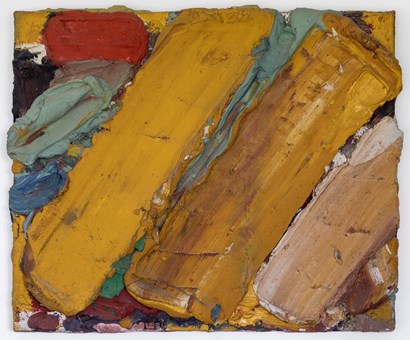
Samuel Vanhoegaerden Gallery
Bram Bogart (Delft 1921-2012 Sint Truiden) Hooigang, September 1964 Mixed media on canvas, mounted on wooden panel 106 x 124 cm Signed, dated and titled on reverse Provenance: D & R Hughes, London, 1989; private collection, Belgium Literature: Bram Bogart, The early years, 1951-1965, D & R Hughes, 1989, ill. n° 49
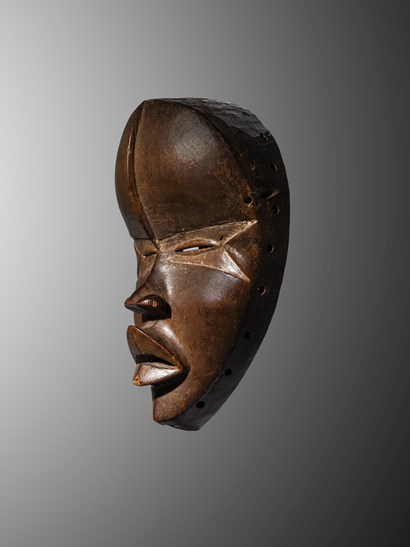
Claes Gallery
Dan 'deangle' Mask Ivory Coast, Dan people Presumed early 20th century Wood and pigment H 25 cm Provenance: Hubert Goldet (1945–2000), Paris, until 1972; Lucien Van de Velde (1933-), Antwerp, from 1972 to 1975; René (1901-1998) & Odette (1925–2012) Delenne, Brussels Literature: Arts d’Afrique Noire 34, 1988, p. 49; Utotombo, Kunst uit Zwart-Afrika in Belgisch privé-bezit, de Heusch, Brussels, 1988, p. 148, fig. 59; A ‘Harley Mask’ at the Cleveland Museum of Art: More on Masks among the Mano and Dan Peoples, Petridis, African Arts, Vol. 45, n° 1, 2012, p. 31, fig. 8; Trésors de Côte d’Ivoire, Neyt, Fonds Mercator, Brussels, 2014, p. 44-45, fig. 18 (indication: H. 26 cm); The Language of Beauty in African Art, Petridis, The Art Institute of Chicago, 2022, p. 207, fig. 164 Exhibitions: Utotombo. Kunst uit Zwart-Afrika in Belgisch privé-bezit, Palais des Beaux Arts, Brussels, 25 March-5 June 1988; The Language of Beauty in African Art, The Art Institute of Chicago, Chicago, 20 January 2022-27 March 2023 Originating from the northwest of Côte d’Ivoire, near the borders of Liberia and Guinea, the Dan are an agricultural people who primarily cultivate rice and cassava. Their way of life, complemented by hunting, fishing, and gathering, is rooted in a patrilineal society without a central authority, structured around clans led by chiefs chosen for their prestige, bravery, or agricultural success. Relations between clans, often marked by rivalries, gave rise to a rigorous social organization: young warriors ensured the group’s defense, while chiefs reinforced their influence through feasts and gifts. Local power rested on a balance between the chief, the council of elders, and the male associations, which upheld discipline, guided the initiation of young men, and preserved community cohesion. The Dan distinguish between two worlds: that of the village - a humanized and social space - and that of the forest, the realm of spirits and natural forces. It is within this duality that their art takes root, renowned for its independence and for the diversity of its styles from one village to another. In their pursuit of formal perfection, Dan artists express through their works an ideal of beauty that is both spiritual and harmonious. A symbol of this aesthetic quest, the Dan 'deangle' mask is characterized by its regular oval shape, polished surface, narrow eyes, short nose, and full, slightly parted lips. The raised scarifications emphasize the geometry and graphic strength of the composition. Of an elegance imbued with softness and femininity, it embodies the Dan ideal of beauty. Used within the Leopard secret society (go), associated with the pacifying spirit zlan, this mask served as an intermediary between young initiates and the village community. First exhibited and published for the general public in 1988, this exceptional work was most recently presented (in 2022) at the Chicago Museum. The mask’s deep gaze, highlighted by a fine band across the eyes, captures the viewer’s attention. Its patina, with warm brown reflections, and its concave form lend it a presence that is both powerful and serene.






